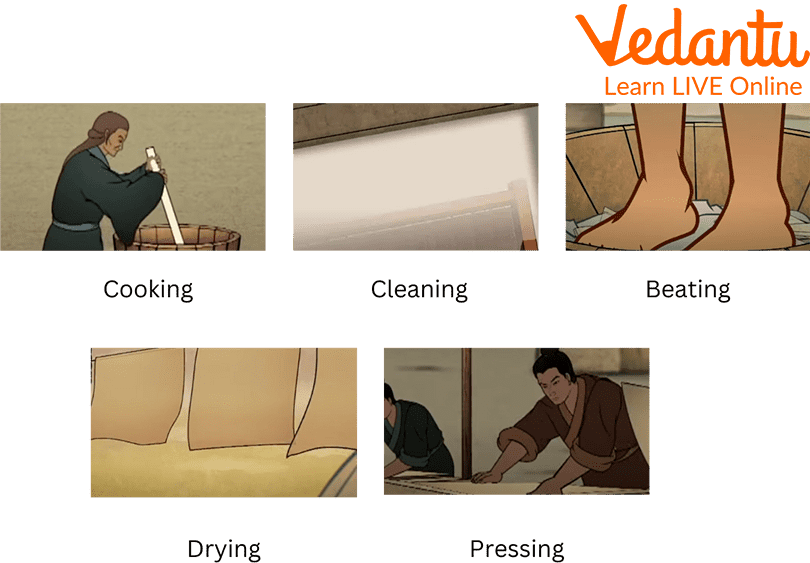




How Paper Supports Learning, Organization, and Creativity
Paper is a thin nonwoven fabric traditionally made from a mixture of milled plants and fibres. Paper is a thin substance that people use for writing, printing, wrapping, and numerous other purposes. People generally make paper out of natural fibres, or lengthy, thin strands of plant material. Today maximum paper comprises wood fibres, called wood pulp.
Nowadays paper is used in many hands-on activities in schools, kids use paper to make things with paper for kids in various activities. You know some uses of paper as you use it in the study but have you ever wondered how paper is made? Let's now study more about the paper in this article.
How is Paper Made?
Paper is made in two steps:
Cellulose fibres are removed from a variety of sources and renovated to a pulp.
Pulp is blended with water and placed on a paper-making machine where it is smoothed, dried, and cut into papers and rolls. You will understand this process through the cycle of paper making process given below. This process starts in the forest and ends at transportation from the flight.

A Paper-Making Process
Forestry Products
Most paper is formulated from forestry products, usually trees. The largely common trees that paper comes from are:
Spruce
Pine
For
Larch
Hemlock
Eucalyptus
Aspen
Birch
In most cases, the best portions of these trees are used for construction, and less preferable fractions are used in pulp.
Cotton and Other Natural Fibres
Natural fibres such as cotton are utilised sometimes because their fibres are extremely strong. This makes it an outstanding choice for documents that may require be archived. This strength, integrated with its unique feel is why cotton paper is prominent for letterhead and other corporate stationery products.
Recycled Fibres
Many papers include several types of recycled content. These include:
Pre Consumer Waste (paper garbage from the paper manufacturing and printing processes)
Post-Consumer Garbage (paper waste that has already reached a consumer, like a recycled newspaper)
How is Paper Pulp Made?
Although many fibres were referred to above, forestry products are the basis of most fibre in paper pulp. There are three major components, which must all be segregated to make pulp.
Bark
Fibre
Lignin
The bark conserves the fibres of the log, which are held jointly by lignin. The goal is to remove the fibres, and this is accomplished either using a chemical or mechanical process.
Paper mills all work with a slight difference, so please keep in mind that these are abstractions.
History of Paper
The first paper-like plant-based writing paper was papyrus in Egypt (4th Century BC), but the first true paper, the first valid papermaking process was reported in China during the Eastern Han period (25–220 CE), culturally attributed to the court of the official Cai Lun. This plant-pure coalition produced by pulp mills and paper mills was utilised for writing, drawing, and money.
The process of making paper used in history is given below in the picture. It includes cooking, cleaning, beating, drying, and pressing.

History of the Making of Paper
During the 8th century, Chinese papermaking circulated in the Islamic world, replacing papyrus. By the 11th century, papermaking was sent to Europe, where it replaced animal-skin-based parchment and timber panels.
By the 13th century, paper making was refined with paper mills utilising water wheels in Spain. Later modifications to the papermaking process came in 19th century Europe with the innovation of wood-based papers.
Uses of Paper in Daily Life
There are many several types, or grades, of paper. Daily writing and printer paper, called a bond, is thin and smooth. Few papers, especially paper used for arts & crafts, are thicker and occasionally textured. Cardboard is a rough, thick type of paper utilised to make boxes and other packaging. The paper used for newspapers, called newsprint, is thin and cheap. Converted paper is made from used paper or leftover bits of modern paper.

Use of Paper as the Newspaper
The Paper has many other logical and creative aims. People use paper to make books, cards, gift wraps, cash, egg cartons, and hundreds of other commodities.
Summary
In this article, the whole lifecycle of a paper is discussed. Firstly you read how paper is made, this paper making process starts from forest then timber comes to factories and the process ends with transport. Recycling paper is essential as it balances the ecosystem. The history of paper and daily uses of paper are also discussed here. The importance of paper-making commerce in the newspaper advertisement procedure is evident. It is crucial to understand the process of the paper-manufacturing sub-sector. Further, it calculates the amount of waste published into the environment by the manufacturer.
FAQs on Uses of Paper in Daily Life: Essential Roles & Everyday Benefits
1. What are the most common uses of paper in our daily lives?
Paper is a versatile material with many everyday uses. Its primary roles include:
- Communication: Writing letters, printing books, newspapers, and magazines.
- Education: Using notebooks, textbooks, and answer sheets for learning and exams.
- Packaging: Making cardboard boxes, paper bags, and food wrappers.
- Currency: Printing money or banknotes.
- Hygiene: Manufacturing products like paper towels, tissues, and toilet paper.
- Creativity: Using it for drawing, painting, and crafts like origami.
2. What are some key examples of how paper is used in a school environment?
In schools, paper is essential for education and administration. Key examples include textbooks for studying subjects, notebooks for writing down notes and homework, answer sheets for examinations, chart papers for projects and presentations, and art paper for creative activities like drawing and painting.
3. Why is paper considered such an important invention for human civilisation?
Paper is considered a revolutionary invention because it made information accessible and affordable. Before paper, writing materials were expensive and difficult to produce. The invention of paper allowed for the mass production of books and documents, which played a crucial role in spreading literacy, preserving history, advancing education, and accelerating scientific discovery across the world.
4. How have the uses of paper changed in the modern digital age?
While digital screens have replaced paper for some tasks like reading news or sending messages, paper remains important. Its modern uses have evolved. Today, there's a greater emphasis on sustainable packaging (like cardboard boxes for online shopping) and speciality papers. While writing on paper has decreased, its use in official documents, legal contracts, currency, and as a preferred medium for creative arts continues to be significant.
5. If paper is so useful, why are we encouraged to reduce its consumption?
We are encouraged to reduce paper consumption due to its environmental impact. The production of paper involves:
- Deforestation: Large numbers of trees are cut down, which harms forests and wildlife habitats.
- High Water and Energy Use: The manufacturing process consumes enormous amounts of water and energy.
- Pollution: Paper mills can release chemicals into the air and water.
Therefore, reducing, reusing, and recycling paper helps conserve natural resources and protect the environment.
6. What makes paper different from older writing materials like papyrus or clay tablets?
Paper offered significant advantages over older materials. Unlike heavy and brittle clay tablets or expensive papyrus, paper is lightweight, flexible, and relatively inexpensive to produce. Its smooth, absorbent surface made writing with ink much cleaner and faster. These qualities allowed for the easy creation of portable books and documents, making knowledge more mobile and accessible to a larger population.
7. Besides writing, what are some creative and decorative uses of paper?
Paper is widely used for creative and decorative purposes. Some popular examples include origami (the Japanese art of paper folding), creating paper flowers, making greeting cards, designing wallpaper for homes, and using papier-mâché to build sculptures and masks. Coloured and textured papers are also used in scrapbooking to preserve memories.
8. What materials were used to record information before paper was invented?
Before the invention of paper, various materials were used for writing and recording information. Ancient civilizations wrote on wet clay tablets which were then dried, papyrus scrolls made from a plant in Egypt, parchment and vellum made from treated animal skins, and even on bamboo strips, palm leaves, and silk in different parts of the world.















